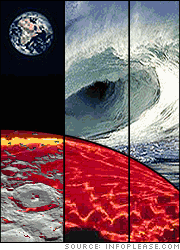Potential Disasters

Scientists warn potential disasters threaten the U.S.
Are the odds worth the worry?
by David Johnson |
 The British government appointed a commission to assess the chances that an asteroid could destroy or damage the Earth. The Near Earth Objects Task Force will monitor objects whizzing through space. Related Links |
"My life has been full of terrible misfortunes that never took place," French writer Michel Montaigne once said.
Many people waste time and energy worrying about things that haven't happened—and probably won't. But when scientists say that seemingly unbelievable disasters have a good chance of occurring, government safety officials sit up and take notice.
Threat from Outer Space
It may sound like a science fiction movie, but in January 2000, the British government appointed a commission to assess the chances that an asteroid could destroy or damage the Earth. The Near Earth Objects Task Force will monitor objects whizzing through space, according to the BBC. Some British experts claim the chances of being killed by an asteroid are 750 times greater than winning the British lottery.
Last year, an object passed between the Earth and the Moon, which would have likely caused enormous damage if it had hit Earth.
Asteroids can be devastating. It is believe that an immense meteorite crashed to Earth 65 million years ago, wiping out the dinosaurs. National Geographic magazine reported that in 1992, a piece of rock the size of a football tumbled from the sky to crush a car in New York City. In 1908, nearly 800 miles of Siberian forest burst into flame when a meteor landed in the area.
On average, a large object hits every 10,000 years, while something with the force of 10 atom bombs crashes every 100,000 years. However, you do not need to put on your crash helmet just yet. There are no known objects close enough to Earth to cause damage for some time.
Will Wall of Water Wash East Coast?
Volcano experts say that if a volcano in the Canary Islands were to fall into the Atlantic Ocean, it would send a wall of water, a tsunami, to engulf much of the East Coast of the United States. The Cumbre Vieja volcano on the island of La Palma is unstable and could collapse if it erupted. The 500 billion tons of rock plunging to sea would create a splash more than 2,100 feet high and 25 feet across that would surge across the ocean toward America at 450 mph.
By the time it reached the U.S., the killer wave would be only about 160 feet tall. Even so, it could sweep inland for 12 miles.
In 1998 an underwater earthquake created a tidal wave that killed 2,000 people when it smashed into Papua New Guinea. In 1958, a cliff fell into the ocean at Letuya Bay. The resulting water wall was so strong it removed trees and soil 1,640 feet above sea level.
Again, scientists say it could be decades before Cumbe Veija erupts again and that event may not be catastrophic.
Yellowstone Explosion Could Freeze Earth
A supervolcano beneath Yellowstone National Park could be overdue for an eruption, according to scientists. The explosion would send ash, dust, and sulfur dioxide into the atmosphere, reflecting the sun's rays and creating a cold wave lasting several years. Crops in many areas would fail and many species of animals and plants would face extinction.
The Yellowstone volcano has erupted once every 600,000 years, and is now 40,000 years overdue, making some volcano watchers nervous. Satellite pictures show movement in the chamber of molten rock several miles beneath the earth's surface.
A supervolcano is usually formed when the mountain around the crater collapses during an eruption, leaving a large crater, or caldera.
Sources: BBC News, Infoplease.com







